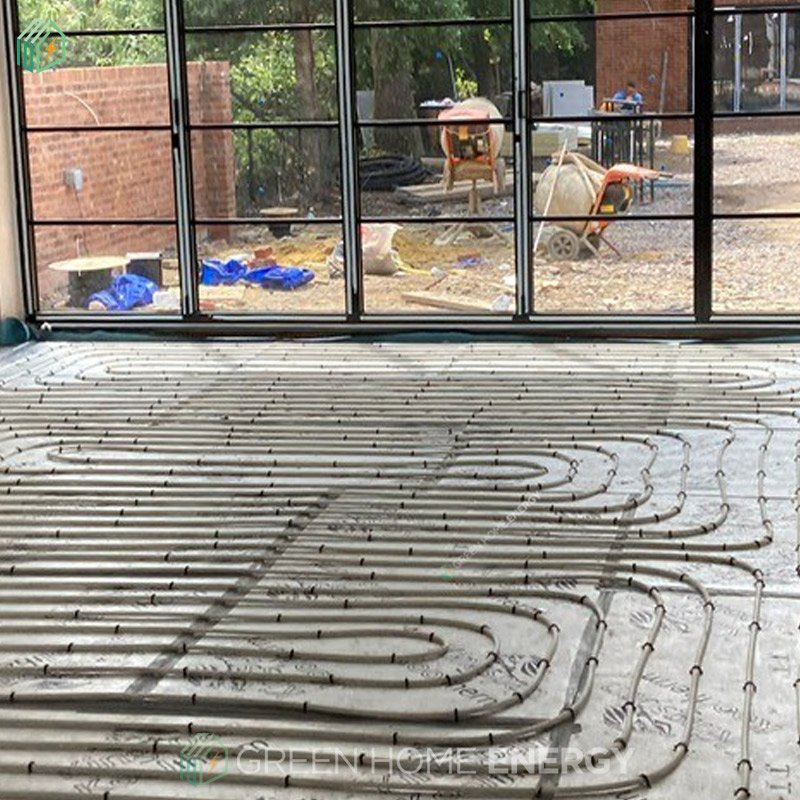Under Floor Heating




Underfloor Heating for Ultimate Comfort. Space-Saving, Energy-Efficient Warmth Beneath Your Feet
The Under Floor Heating (UFH) system has become an extremely popular choice for homeowners looking for efficient and comfortable ways to heat their home, offering several advantages over radiators. The water or wet UFH transforms your entire floor into an energy-efficient heat pad and is a cost-effective alternative to central heating radiators. You do not need the radiators, resulting in a spacious, streamlined interior. UFH provides a balanced level of radiant heat and air warming.
UFH is probably the most comfortable, efficient, and effective way to control temperatures indoors. As an emitter, UFH warms a room using radiant heat rather than by very localised hot air circulation which is typical of radiators.
Heating over a large area means that water UFH uses cooler water than traditional radiator-based systems, making it a fuel-efficient and environmentally friendly choice. Good UFH uses low temperature water and this lower running temperature is perfect for modern green systems like air-source or ground-source heat pumps. If the heating is provided by high air temperatures with radiators, this can dry the skin and eyes. UFH removes the need for radiators by making more effective use of the space, as well as eliminating any high temperature surfaces.
The UFH works seamlessly under various types of flooring, including tiles, wood, and carpet, allowing homeowners to choose their preferred flooring without compromising on comfort or heating performance. Wet UFH circulates warm water through pipes installed beneath the floor. This provides consistent and efficient warmth throughout the space above. UFH eliminates the need for radiators, alleviating cold spots and clearing precious wall space and the rooms become more adaptable, allowing more versatility when placing furniture.
UFH not only boosts comfort but also highlights the aesthetic appeal of tiled floors, creating a luxurious and sophisticated atmosphere. UFH with tiled floors create the ultimate combination, enhancing both comfort and functionality in any home or business. Tiles, known for their cool surface, can often feel uncomfortably cold, especially during the winter months. However, with the UFH, this is no longer an issue. The gentle heat generated from beneath the floor keeps the tiles warm to the touch, ensuring you never experience cold feet again.
Comfort That Rises from Below
Underfloor Heating enhances your space with silent efficiency.
Frequently asked questions (FAQs)
You need to compare the relative surface area of a radiator versus UFH to understand their relative efficiencies. The greater the surface area of the emitter, the cooler the temperature needs to be to achieve the same result. UFH systems extend across a room, whereas radiators are placed in specific locations. This relative size differential explains why an UFH system can run effectively at lower water temperatures around 400C than radiators around 700C. This makes water UFH more efficient than radiator systems when paired with an Air Source Heat Pump or a Ground Source Heat Pump.
Water UFH is versatile and suitable for both new builds and retrofit projects. The UFH can be used in various situations including new screed floors, joisted floors, and solid existing floors.
The speed at which a house warms up is down to the efficiency and responsiveness of the heating system. It is important to ensure that the UFH has been designed and installed correctly allowing for the system to work optimally. It is easy to blame the heat source if it seems to take a long time to heat. For example, if UFH pipes are embedded in a thick concrete slab then it will have a longer warm-up time than dry construction systems in suspended, batten or floating floors.
The type of floor finish will also make some difference, e.g., tiles are highly conductive, while carpet and underlay are far less conductive. Wooden floors can also prove problematic for some brands of UFH because timber is not a good conductor of heat, so the system may require a higher water temperature to warm the room.
Tiles are an ideal material for UFH due to their high thermal conductivity as they transfer and retain heat efficiently. This allows tiles to heat up quickly and distribute warmth evenly across the room. Tiles are also great at maintaining their durability and aesthetic appeal even with constant temperature changes, making them a long-lasting and visually pleasing flooring option UFH systems.
There are UFH systems designed for all types of wooden floors. Some wood UFH systems can be installed directly under your wooden floors, providing a consistent and even heat output across your entire space. The wooden floors are energy-efficient and environmentally friendly, helping to reduce your carbon footprint and lower your energy bills. They are highly durable and built to last, so you can enjoy the benefits of UFH for many years to come.
Carpet is suitable for UFH. However, when using carpets with UFH, we recommend keeping to thinner materials, as thicker carpets will slow down the heat transfer. Additionally, it is important to consider that the combined value of the carpet and underlay should not exceed 2.5 tog, and preferably less than 1.5 for systems with a heat pump. These are just a few important factors to consider for optimal performance of your system.
Vinyl is known for its versatility and durability. It is naturally warmer underfoot than some other materials. The warmth beneath the vinyl floor ensures a consistent and gentle heat that will make walking barefoot a pleasure, in any room across your house. This combination will improve comfort and enhance the aesthetic appeal of a vinyl floor, creating a stylish and cosy place to live, play or work.
There are three main types of vinyl flooring: luxury vinyl tile (known as LVT), luxury vinyl plank (LVP) and sheet vinyl. All three types of vinyl flooring are suitable for UFH. However, we advise to check the maximum floor surface temperature that the manufacturer has set for their flooring. For rule of thumb, a vinyl flooring that allows temperatures of at least up to 27 degrees will be fine for UFH.
Laminate UFH is an innovative and practical solution for maintaining a comfortable temperature in your home. By installing electric or water-based heating elements beneath your laminate flooring, this system efficiently distributes heat upwards, ensuring even warmth throughout the room.
Let’s connect today
Have a query or need expert guidance on renewable energy solutions? Our friendly team is here to help so contact us and let’s build a greener future together.
SEND US A MESSAGE
CONTACT INFORMATION
Do you have questions about our services & solutions? Send us an email and we’ll get in touch shortly.
Follow Us
Connect with us to discover the latest in green energy, expert tips and exclusive offers. It only takes a second to stay informed and power your home sustainably!








